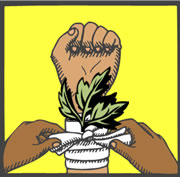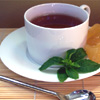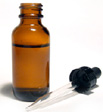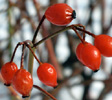See more in our Learning Center >
In my experience herbs are tonic, meaning they improve a person’s general health and the body’s ability to heal itself. Herbs are used world-wide for healing, and also in food preparation. See how to make herb-infused oils and vinegars, and cook with combinations of herbs with specific foods on the Culinary Uses of Herbs page.

Herbs are less chemically toxic than over-the-counter drugs. Now-a-days, many people are on multiple medications, whether over-the-counter or prescribed. In all my years of practice as a consultant, I have never seen interactions with medications. Always make sure you check with your heatlhcare professional and pharmacist. — Dave Card
| Always be cautious In consultation with a physician, usage of herbal remedies should be clarified, as some herbal remedies have the potential to cause adverse drug interactions when used in combination with various prescription and over-the-counter pharmaceuticals. For example, dangerously low blood pressure may result from the combination of an herbal remedy that lowers blood pressure together with prescription medicine that has the same effect. In particular, most herbs should be avoided during pregnancy. |
Herbs in Capsule
Capsules are an excellent way to use or ingest herbs, and are a convenient way to store herbs. Many herbs are bitter or generally not very palatable. It’s also an excellent way to blend the herbal combinations you desire. Capsules are more convenient when you are on the go or need to take them at work or while traveling, and have the advantage of being stored in bulk in bottles, jars, etc.
General Use: begin by using one capsule three times a day, and working up to using the therapeutic dose of 2 capsules 3 times daily. Remember to check with your doctor before starting any natural supplement.
To fill your own capsules make sure to use dry powdered herb, or crush any herb into powder before filling. Using a capsulating machine can save time.
Herbs in Tea
Tea Is an excellent way to gain health benefits from herbs, and has been used for centuries both as an enjoyable beverage consumed for the enjoyment of taste and also prepared for medicinal purposes.

Today access to commercially blended teas is innumerable. But did you know that you can blend your own teas specific to your tastes and needs?
There are two basic types of teas: infusions and decoctions. When you pour hot water over a tea bag, you have made an infusion; an infusion is simply herbs steeped in hot water. To make a decoction herbs are boiled in water. Decoction is used to extract the nutrients from woody stems, bark, roots and seeds. An example of a decoction would be simmering cinnamon sticks and cloves in apple cider. As a general rule, leaves and flowers are best infused; boiling can cause them to lose their volatile (essential) oils.
To prepare an infusion, use 1 tablespoon of herbs per cup of water. Pour the hot water over the herbs in a pot or teapot, cover with a lid, and allow to steep. Drain or strain herbs off. To make larger quantities of hot infusions use about 1 oz herbs per pint of water.
To prepare a decoction use 1 tablespoon herbs per cup water, cover, and gently boil for 15-30 minutes. Use glass, ceramic pots to make your decoction then strain the decoction.
Enjoy blending and drinking your own special blends of your favorite tea.
Herbs in Poultices
A Poultice is a thick paste usually of chopped, ground or crushed fresh (or dried but remoistened) plant material. The word “poultice’ ( pole – tis) is derived from the Latin pultes, the plural of puls, meaning a porridge or pottage.

Poultices and compresses are very effective because the skin, the largest organ of the body, has the ability of absorption. By applying an herbal poultice to the painful, inflamedor infected area, the skin absorbs the medicinal benefits of the substance almostimmediately. The poultice is usually held in place by a wet compress that is covered by a bandage.
Most poultices are made from the fresh herb or dried re-constituted herbs. (Herbs may be reconstituted with a little water.)Poultices are referenced as and become plasters when finely ground herbs or added ingredients such as cornmeal or wheat flour are used to assist in their cohesiveness.
Making a Fresh Herb Poultice: Using a blender or food processor, take a handful or two of the herb, about 1 – 2 cups depending on the size of the area to be treated, and add with water preferably distilled or bottled. Puree the mixture pulsing as you would when preparing pesto. If a blender of food processor is not available, crush and blend by hand. The poultice may be heated to increase circulation and for drawing out toxins, or left cool for sunburn and skin irritations.
Herbal Salves and Ointments
A salve is typically made with a base of oil, petroleum jelly or a resin. Olive oil is usually the base oil of choice.
Herbal Salves are easy to make at home: Start by making an infused oil by covering fresh or dried herbs with water. Bring to a boil and then simmer for 20-30 minutes. Then strain the prepared preparation and add an equal amount of olive oil. Then reheat and simmer until the water has evaporated and only the oil remains. Beeswax is added to the mixture to obtain the consistency of a salve. Esscential oils may also be added for fragrance and healing benefits. When complete, label and store in small jars. Salves may last up to a year.
Herbal Tinctures
Herbal tinctures are potent (concentrated) spirit based, liquid extracts. Tinctures contain the plant’s healing properties in a small dose. They last for a long time, and are easy to store. Tinctures are an inexpensive way to build your herbal first aid kit. Since they are so concentrated they tend to work faster, and more effectively than herbal teas or capsules.

They are made using fresh or dried herbs and a liquid base such as vodka or brandy. Apple cider vinegar and vegetable glycerin are also used.
Most tinctures are made using vodka. It’s affordable and easy to obtain. Alcohol has great extraction power. Caution: Using less than 80 proof (or 40 percent alcohol), you run the risk that the tincture will not be adequately preserved.
To make an herbal tincture, there are several exact formulas, but to get started and to obtain excellent results you can follow the basic instructions:
Put your herbs, in sterilized glass jar, (dark glass) is preferable. If you use a canning jar store it in a dark space. Pour enough alcohol in to cover it and you’ll have a workable macerate. Put a cover on the jar, shake well, and put in a cool, dark place. Allow the herbs to steep in the alcohol for six weeks, shaking the jar daily. After six weeks, strain the herbs out of the alcohol and pour liquid into a clean, sterile jar. Cover with a lid and label. Store in a cool, dry place.
Herbal Syrups
Herbal syrups can be fun to make and serve many purposes. Some herbal syrups can be used as culinary delicacies while other syrups can be formulated to address specific ailments. See more uses of culinary herbs. Syrups can make even the most bitter herbs taste good. They’re ideal for coating and soothing sore throats and respiratory ailments.
Herbal syrups can be fun to make and serve many purposes. Some herbal syrups can be used as culinary delicacies while other syrups can be formulated to address specific ailments. See more uses of culinary herbs. Syrups can make even the most bitter herbs taste good. They’re ideal for coating and soothing sore throats and respiratory ailments.

Elderberry and choke cherry and rose hips syrups are superb flavored syrups. Medicinal syrups have been traditionally used for treating coughs, sore throats and digestive problems. Most syrups that we are most familiar with are made from a concentrated solution of sugar in water. Other sweeteners are also used.
To make an herbal syrup: add about two ounces of dried or fresh herb to one quart of water. Bring to a gentle boil, then simmer until liquid is reduced to one pint. Strain, and while the liquid is still warm, add the sweetener (sugar, honey, etc) and continue boiling the sugar/herb mixture to a desired consistency and potency.
Copyright© 2019 by David R. Card